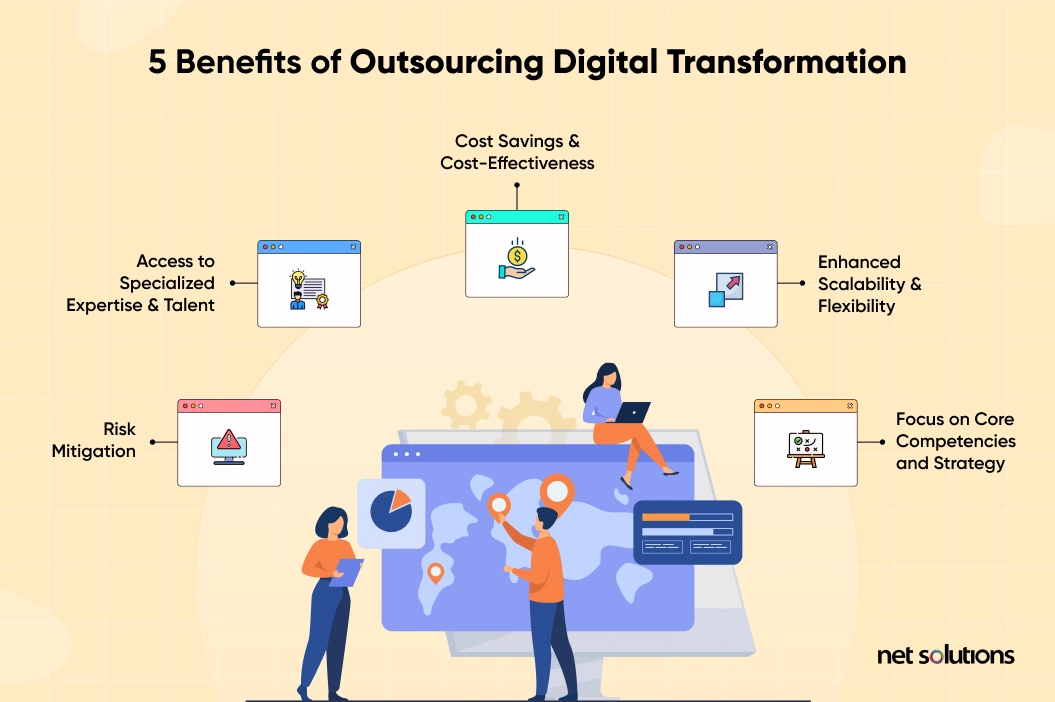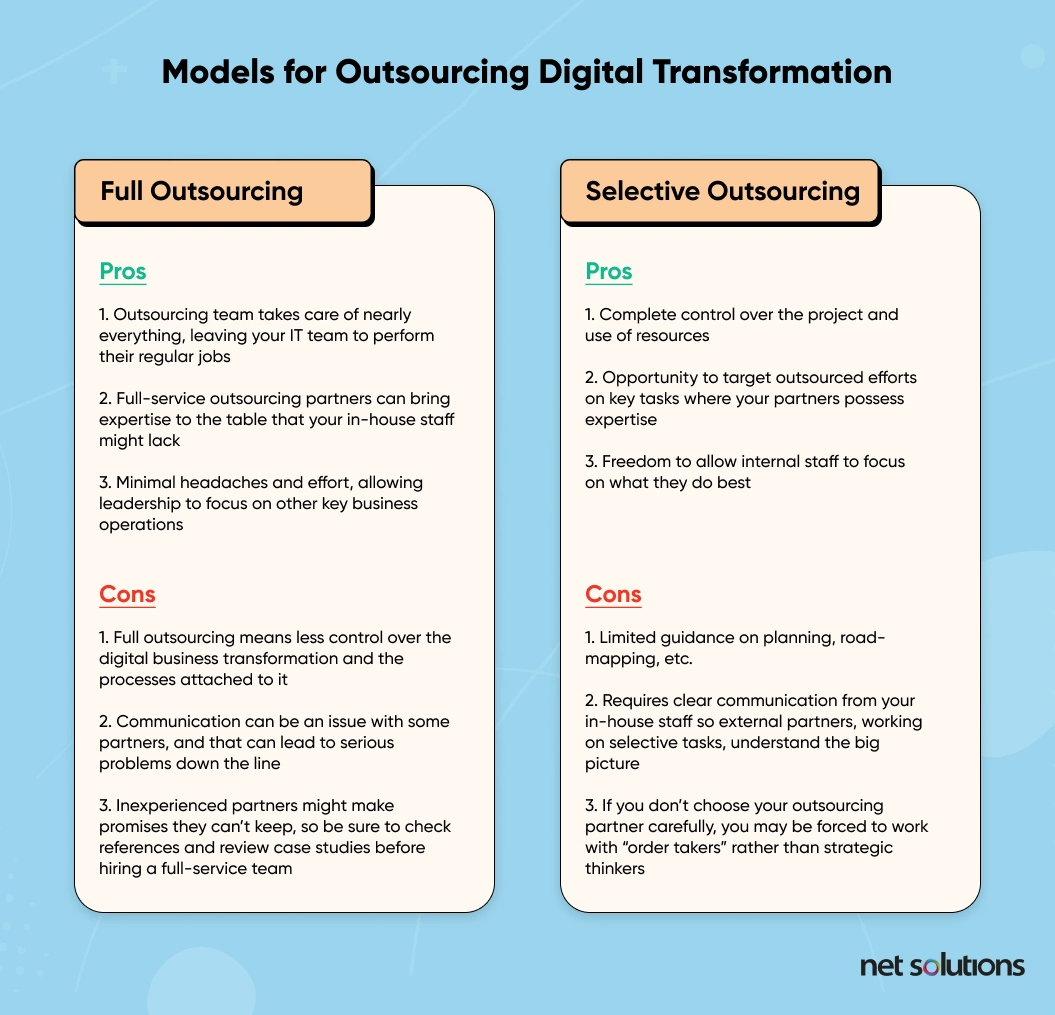Ongoing digital transformation is key to remaining competitive, earning profits, and providing an unforgettable customer experience in today’s fast-changing world. To that end, many companies rely on outsourcing to support their transformation initiatives.
In this blog post, we’ll explore both the benefits of outsourcing digital transformation along with the pros and cons of different outsourcing models. We’ll also address scenarios in which outsourcing might not make sense for your organization.
Read on to see how you can make the right decision for your business.
5 Benefits of Outsourcing Digital Transformation
A 2022 McKinsey study found that each year, digital transformation makes up an increasingly larger percentage of the total contract value of outsourcing initiatives. Over the four-year period they studied, the average percentage of total outsourcing contract values dedicated to digital transformation grew from 30% to 70%.
Why are so many companies outsourcing their digital transformation projects? Here are five reasons why outsourcing is an attractive option for many businesses, helping to maximize ROI on your efforts.

1. Cost savings and cost-effectiveness
Outsourcing all or part of your digital transformation process can offer significant savings compared to hiring in-house staff to handle everything.
What makes outsourcing more affordable in most cases?
- Full-time employees include hidden expenses, such as benefits and payroll taxes
- Outsourcing overseas can save money due to cost-of-living differences
- The hiring and onboarding process itself chews up resources and eats into profits
- During periods of downtime, you still need to pay full-time employees, whereas outsourcing agreements can scale based on a company’s needs
Outsourcing is a great way to protect your bottom line and adopt a powerful transformation strategy.
2. Access to specialized expertise and talent
Beyond the numbers on the balance sheet, asking in-house teams to complete tasks where they lack expertise can result in rework, which impacts profits. In more serious cases, it can lead to critical technical problems that result in lost business and harm your brand’s reputation.
For these reasons, companies often hire outsourcing partners to address business needs where their in-house staff lacks expertise and experience.
Instead of burdening an overworked staff with learning about new digital technologies, they simply find IT outsourcing teams that specialize in those areas.
That’s not a slight against anyone’s internal IT department. Technology is a vast and complicated field, and nobody is an expert in everything. Often it’s ideal to let your in-house teams do what they do best and hire experts for the rest.
3. Risk mitigation
Digital transformation is a complex process, and hiring external providers often helps mitigate risks that could sink your digital transformation—or even destroy your business!
What are some of the risks associated with digital transformation?
- Downtime when transitioning to new technologies that could impact productivity as well as the User Experience (UX)
- Security issues that could open you up to cybercrime, compromise your data and customer privacy, and harm your brand’s reputation
- Improper planning that unnecessarily extends the project timeline and impacts the budget
- Failure to modernize apps strategically, creating incompatibility between legacy apps and modern apps as technologies change
In-house IT teams often value the help of outside IT service providers who can guide their business transformation, help them overcome common digital transformation challenges, and set them up to achieve their business goals.
Before you begin your transformation, check out our complete digital transformation checklist to make sure you’re on the right track.
4. Enhanced scalability and flexibility
Business moves fast and change is inevitable. Most companies experience ups and downs in digital demand, and if your IT teams are working at maximum capacity, they will struggle to add digital transformation to their growing task lists.
Hiring an outsourcing partner provides flexibility since they can augment your internal efforts to handle new projects and spikes in workload. And when things calm down? You don’t have to pay them to sit around and wait for work.
5. Focus on core competencies and strategic initiatives
Don’t limit your digital transformation efforts to the knowledge and skill set your staff currently possesses—that’s a recipe for an incomplete, haphazard digital transformation.
Engaging the outsourcing services of an experienced third party allows your team members to focus on what they do best. Instead of burdening your in-house staff, you can choose your outsourcing partner carefully, based on their core competencies.
Choosing the right external team will result in a partnership where everyone benefits: leaders, staff, and customers.
When Not to Outsource Digital Transformation
Net Solutions is a full-service outsourcing provider, so you might expect us to push outsourcing for every scenario—but that’s not how we do business!
We only want to work with clients who will genuinely benefit from our services, whether we’re working on software development or full-scale digital transformation projects. And the truth is, some companies aren’t ideal candidates for outsourcing digital transformation at their current stage.
When should you hold off on outsourcing? If your in-house staff has both the time and the expertise to handle every aspect of your digital transformation, and you’re not planning to downsize anytime soon, then there’s no need to look for outsourcing partners right now.
Now, some companies avoid full outsourcing because they’re looking for complete control over the project, but keep in mind that you can maintain control by choosing a “selective outsourcing” model. In that scenario, your in-house staff can take care of your core business technologies and overall planning, leaving you in control of the project.
That’s how selective outsourcing differs from “full outsourcing.” We’ll explore both models in the next section.
Models for Outsourcing Digital Transformation
Outsourcing isn’t an all-or-nothing approach to digital transformation and optimization. In other words, you don’t have to outsource your entire digital transformation to a third party if you’ve got a strong in-house team and you’d like to divide those responsibilities.
What follows is an explanation of two main models for outsourcing: full outsourcing and selective outsourcing. Read the descriptions below to determine which approach gels with your business model.

1. Full outsourcing
A full outsourcing model involves handing over the reins of your entire digital transformation project. That means your full-service outsourcing partner will take charge of things like:
- Assessing your current needs
- Building a digital transformation roadmap
- Project management
- App modernization
- Cyber security
- Data management
- Infrastructure improvement
- All other aspects of your digital transformation
You and your staff will consult your outsourcing partners to identify your needs and ensure they’re being met, but you will rely on your partners to manage and execute the project.
This model is ideal for companies with busy IT teams who don’t have the time or expertise to manage digital transformation. Of course, it also works for companies that don’t have any internal IT staff.
If you adopt a full outsourcing model, be sure to choose a partner with a proven track record, because if they don’t know what they’re doing it could cripple your business.
Full Outsourcing Pros and Cons
| Outsourcing team takes care of nearly everything, leaving your IT team to perform their regular jobs | Full outsourcing means less control over the digital business transformation and the processes attached to it |
| Full-service outsourcing partners can bring expertise to the table that your in-house staff might lack | Communication can be an issue with some partners, and that can lead to serious problems down the line |
| Minimal headaches and effort, allowing leadership to focus on other key business operations | Inexperienced partners might make promises they can’t keep, so be sure to check references and review case studies before hiring a full-service team |
2. Selective outsourcing
Selective outsourcing occurs when companies handle the vast majority of the planning, project management, and other tasks internally—assigning specific projects to partners.
Selective outsourcing can work well for companies that have strong in-house teams who understand digital transformation, but might:
- Lack the workforce to complete tasks on time
- Lack expertise in specific areas
- Require IT staff to focus on more pressing concerns, big-picture planning, and other tasks
Selective Outsourcing Pros and Cons
| Complete control over the project and use of resources | Limited guidance on planning, roadmapping, etc. |
| Opportunity to target outsourced efforts on key tasks where your partners possess expertise | Requires clear communication from your in-house staff so external partners, working on selective tasks, understand the big picture |
| Freedom to allow internal staff to focus on what they do best | If you don’t choose your outsourcing partner carefully, you may be forced to work with “order takers” rather than strategic thinkers |
3. The hybrid option
Be aware that there’s a spectrum between full-service outsourcing and selective outsourcing.
You are always free to hire a partner for some big-picture planning and specialized tasks, while reserving key tasks for your internal staff that match their capacity and skill set.
This hybrid model can work well for organizations that have IT staff with varying skill sets surrounding digital transformation processes.
Communication is always vital when working with an outsourcing partner, but it’s especially important when taking a hybrid approach. Clearly define the roles everyone plays upfront, from internal staff to third-party teams.
It’s also important to identify what hours you want your outsourcing partner to work. If they’re located on the opposite side of the country, do you need them to adapt to your work hours? Or would it be better for them to work asynchronously, while your team is off the clock?
Define all these roles and expectations upfront, no matter which model you choose. That will help ensure a successful digital transformation.
Need a Digital Transformation Partner?
Net Solutions has worked with businesses large and small on all aspects of digital transformation, from app modernization to cybersecurity overhauls. We’ve worked with worldwide brands like Euro Car Parts and American Golf, along with lean startups and everything in between.
We can help you incorporate new business models, access big data and customer analytics, tap into automation technology, and build a more customer-centric digital business.






